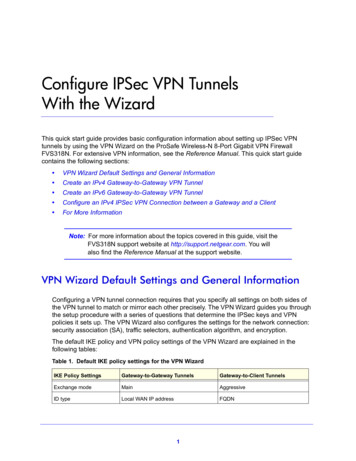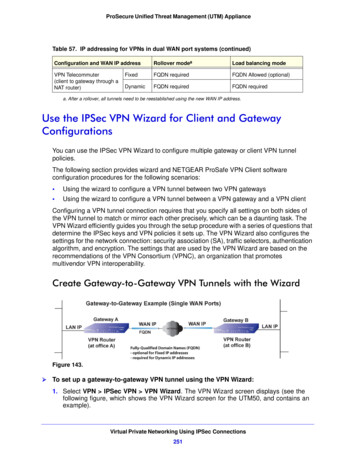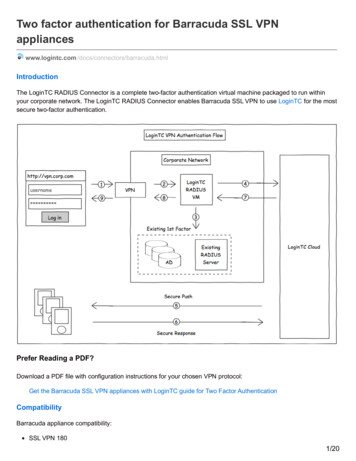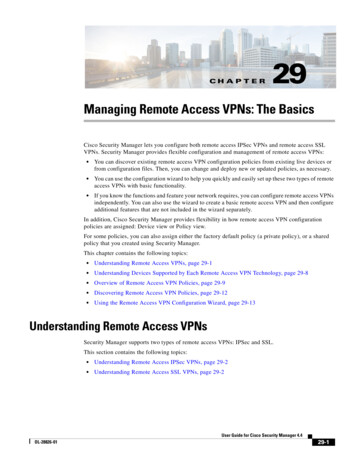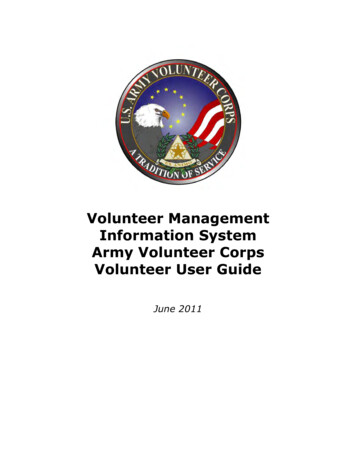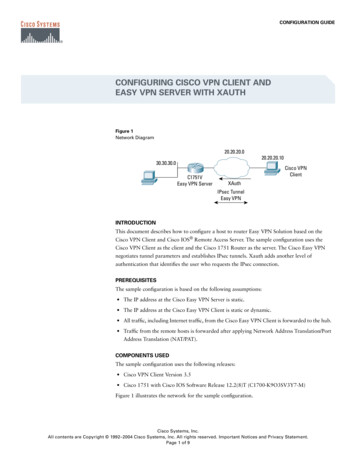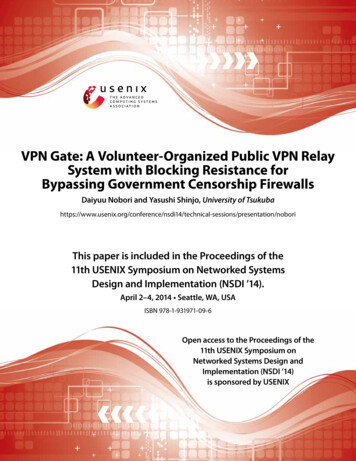
Transcription
VPN Gate: A Volunteer-Organized Public VPN RelaySystem with Blocking Resistance forBypassing G overnment Censorship FirewallsDaiyuu Nobori and Yasushi Shinjo, University of chnical-sessions/presentation/noboriThis paper is included in the Proceedings of the11th USENIX Symposium on Networked SystemsDesign and Implementation (NSDI ’14).April 2–4, 2014 Seattle, WA, USAISBN 978-1-931971-09-6Open access to the Proceedings of the11th USENIX Symposium onNetworked Systems Design andImplementation (NSDI ’14)is sponsored by USENIX
VPN Gate: A Volunteer-Organized Public VPN Relay System withBlocking Resistance for Bypassing Government Censorship FirewallsOperational Systems TrackDaiyuu Nobori and Yasushi ShinjoDepartment of Computer Science, University of Tsukuba, JapanAbstractfirewalls such as the GFW. We call this system VPN Gate.To achieve blocking resistance, VPN Gate uses frequently changing IP addresses that are provided by volunteers. The central list server, called the VPN Gate ListServer, manages a list of the IP addresses of all activeVPN servers. We call this list the Server List. A user canget only part of the Server List and connect his/her PC toan active VPN server in the list. The user can then communicate with blocked Internet servers through the active VPN server. It is hard for a censorship authority toblock all the active VPN servers in VPN Gate.It is important for anti-censorship systems to achieveblocking resistance. We adopted two techniques forblocking resistance: innocent IP mixing and collaborative spy detection. In innocent IP mixing, we include anumber of IP addresses, which are unrelated to VPNGate, in the Server List. For instance, we include vitallyimportant servers (e.g., Windows Update servers). Thistechnique forces a censorship authority to remove innocent IP addresses from the Server List before adding addresses to the firewall blocking list. The second technique, collaborative spy detection, seeks probing activities from censorship authority’s computers, called spies.In this technique all the volunteer VPN servers work together to create a source IP address list of spies, calledthe Spy List, and they ignore probing packets from spies.This technique makes the authority unable to distinguishbetween the IP addresses of active VPN servers and innocent IP addresses or those of inactive VPN servers.The VPN Gate system consists of instances of theVPN Gate Server software, an optional application, theVPN Gate Client software, and a central List Server. Volunteers can easily install and execute VPN Gate Server.For instance, volunteers don't have to configure NetworkAddress Translation (NAT) boxes to open TCP/UDPports. Users can connect to VPN Gate Server with a Secure Sockets Layer (SSL)-VPN protocol by using VPNGate Client. Users can also connect to a VPN server withthe L2TP/IPsec, OpenVPN, and MS-SSTP protocols byusing the built-in, OS-provided VPN clients on PCs andsmartphones. As for the third piece of the system, our research group runs the VPN Gate List Server which accepts registration from volunteer servers, generates theServer List, and distributes it to users.VPN Gate is a public VPN relay service designed toachieve blocking resistance to censorship firewalls suchas the Great Firewall (GFW) of China. To achieve suchresistance, we organize many volunteers to provide aVPN relay service, with many changing IP addresses. Toblock VPN Gate with their firewalls, censorship authorities must find the IP addresses of all the volunteers. Toprevent this, we adopted two techniques to improveblocking resistance. The first technique is to mix a number of innocent IP addresses into the relay server list provided to the public. The second technique is collaborative spy detection. The volunteer servers work togetherto create a list of spies, meaning the computers used bycensorship authorities to probe the volunteer servers. Using this list, each volunteer server ignores packets fromspies. We launched VPN Gate on March 8, 2013. By theend of August it had about 3,000 daily volunteers using6,300 unique IP addresses to facilitate 464,000 VPNconnections from users worldwide, including 45,000connections and 9,000 unique IP addresses from China.At the time VPN Gate maintained about 70% of volunteer VPN servers as unblocked by the GFW.1.IntroductionSome countries in the world have censorship firewallsoperated by their governments to prohibit access to servers in foreign countries. For instance, the Great Firewall(GFW) of China blocks access to Twitter, Facebook, andYouTube. Internet users in countries subject to censorship often use overseas public relay servers to bypasscensorship firewalls. Public proxies, VPN servers, andTor nodes [7] are popular examples of such relay servers.Usually, the IP addresses of relay servers are publicallyavailable for user convenience. A censorship authoritycan easily block these relays, however, by adding the IPaddresses to its firewall blocking list. Moreover, the Chinese authority, in particular, scans for unlisted Tor nodesand blocks them automatically [19]. Tor relays currentlyhave no blocking resistance [12] against such scanningactivities.In this research, we have built a public VPN relayserver system with blocking resistance to censorship1USENIX Association11th USENIX Symposium on Networked Systems Design and Implementation 229
We launched VPN Gate on March 8, 2013. On August 29, we had about 3,000 active VPN Gate servers.This number is comparable to the number of Tor relaynodes. On the same day we had 464,000 connections tothe VPN Gate servers. These connections were from88,000 unique source IP addresses.VPN Gate has blocking resistance against the GFW.Shortly after we started the service, the GFW authorityadded the IP addresses of all the volunteer servers intothe GFW blocking list. On April 4, the GFW blocked81% of all volunteers, so only 19% of active volunteerswere reachable from China. Hence, we implemented theinnocent IP mixing and collaborative spy detection techniques. As a result, we achieved 50% reachability fromChina on April 26, and 75% on May 9. Moreover, around40% of our volunteers’ IP addresses changed every day.The GFW could not catch up to our increasing numberof volunteers and their changing IP addresses. VPN Gatehas thus provided stable reachability for Chinese users.At the end of August, 2013, we have about 45,000 dailyconnections from 9,000 unique IP addresses in China,while Tor had an estimated 3,000 users from China.VPN Gate is a system for bypassing censorship. It isnot an anonymizer. Unlike Tor, VPN Gate volunteerservers record packet logs. VPN Gate also has no multihop relaying function.2.It is not trivial to run Tor relay and bridge nodes.Rbox-Tor helps volunteers run Tor nodes by using virtualmachines [16]. VPN Gate also helps volunteers run VPNservers by a variety of techniques, including NetworkAddress Translation (NAT) traversal capability. We describe this capability in Section 5.2.VPN Gate maintains the list of VPN servers in a centralized server. This mechanism is similar to a tracker inBitTorrent [6]. It is easy for censorship authorities toblock communications to a tracker. To avoid using centralized trackers, BitTorrent introduced a distributedhash table (DHT), implemented in the Mainline and Azureus DHTs [2, 4]. We chose a centralized server insteadof a DHT for two reasons. First, we have to return a different partial server list for each client. Second, we haveto accumulate all information from all active VPN servers in a central server to analyze unusual usages. We describe these design choices in Section 4.3.Many researchers are working on censorship-resistant systems [3, 5, 8, 9, 13, 14, 20]. These systems either are Web-access-specific ones or require modifyingexisting protocol stacks. Here, in contrast, we describe aVPN-based censorship-resistant system that allows using arbitrary protocols without modifying an existingprotocol stack.Many free and commercial VPN services are alsoused to bypass censorship firewalls [10]. Since mostsuch services use a set of centralized VPN servers withfixed IP addresses, censorship authorities can easilyblock these services with firewalls. Some VPN servicesdo have a decentralized or peer-to-peer (P2P) architecture [11, 15]. There have been no published reports orresults, however, on bypassing methods.Finally, our collaborative spy detection technique issimilar to collaborative intrusion detection [22]. In thispaper, we show a specific method to protect VPN servers.Related WorkVPN Gate organizes VPN servers provided by volunteers. This method is similar to that of the well-knownanonymizer Tor [7]. Since communications in Tor are relayed by three Tor nodes to achieve anonymity, they areslow.Tor nodes are classified into two types: public relaysand non-public bridges. It is easy for censorship authorities to block the public relays. Users behind censorshipfirewalls must find non-public bridges through web sites,email, and other means of contact. Although bridges arenot public, censorship authorities can probe and blockthem [18, 19]. Using obfsproxy, it is possible to obfuscate the network traffic exchanged between Tor clientsand bridges [17]. However, Tor bridges currently haveno blocking resistance against such probing activities.Unlike Tor, VPN Gate focuses on bypassing censorship firewalls and does not provide anonymity. Sincecommunications in VPN Gate are relayed by a singleVPN server, they are much faster than in Tor. To useVPN Gate, users behind censorship firewalls must get alist of VPN servers through web sites, email, and so forth.Unlike Tor, VPN Gate also includes innocent IP addresses in a list of VPN servers. We describe this aspectin Section 4.2. Furthermore, VPN Gate has a mechanismmaking it harder for censorship authorities to probe VPNservers. We describe this aspect in Section 4.3.3.VPN Gate OverviewFigure 1 shows an overview of VPN Gate. A volunteerdownloads the VPN Gate Server software and runs it ona PC. While VPN Gate Server is running, it registers itself to the VPN Gate List Server. This server maintainsthe Server List, a list of IP addresses for active VPN GateServer instances.Assume here that a VPN Gate user lives behind acensorship firewall and cannot access blocked servers inforeign countries. The user first accesses a web page forthe VPN Gate List Server to get a list of VPN servers. Toavoid discovery of all VPN servers by censorship authorities, VPN Gate List Server returns only a small part ofthe entire Server List. Next, the user chooses a VPN GateServer instance from the partial list. Finally, the userconnects his/her PC to the chosen server by using eithera native VPN client on the PC or dedicated VPN client2230 11th USENIX Symposium on Networked Systems Design and ImplementationUSENIX Association
software, called VPN Gate Client. Once the VPN connection is established, the VPN server relays all theuser’s communications to the Internet.IPn: The IP address of VPN Gate Server #n.VPN Gate List ServerIP1As described above, a volunteer installs and runs VPNGate Server on a PC. At this time, the volunteer does notneed to show his/her name, address, or any other personal information. While VPN Gate Server is running, itwaits for new VPN connections from users. It acceptsfour VPN protocols: L2TP/IPsec, OpenVPN, MS-SSTP,and SoftEther VPN Protocol.While VPN Gate Server is running, it periodicallychecks the type of Internet connection on the PC. If thePC is behind a NAT box, VPN Gate Server attempts toopen a port via Universal Plug and Play (UPnP) or UDPhole punching. With the recognized type of Internet connection, VPN Gate Server registers itself to VPN GateList Server, which we describe in Section 3.3.IP2VPN Gate Server #11Server list3.1. Hosting VPN Gate Server as a volunteerProvided by volunteers.1VPN Gate Server #21IP3VPN Gate Server #3The free world2Behind thecensorshipfirewall23434Internet servers(e.g. Twitter)VPN ClientUser1. Register itself to the VPN Gate List Server.2. Get the server list directly.3. Get the server list with the Indirect Server List Transfer Protocol.4. Access to Internet servers through the VPN server.Figure 1. Overview of VPN Gate.3.2. Connecting to VPN Gate as a userA VPN Gate user accesses the web site of the VPN GateList Server and obtains part of the Server List. This contains information about volunteer servers, including IPaddresses and port numbers, geographic locations, linequality parameters such as bandwidth and delay, numbers of current VPN connections, and numbers of cumulative VPN connections. The user thus chooses a preferred VPN server from the subset of the Server List.Since censorship authorities can easily discover theweb site of the VPN Gate List Server, a user in a countrysubject to censorship likely cannot access the web sitedirectly. Such a user can instead access it via an HTTPrelay site provided by VPN Gate Server. Section 4.5gives the details of this mechanism.Next, the user can establish a VPN connection by using one of the following methods:Figure 2. Screenshot of VPN Gate Client.3. Using VPN Gate Client.The user installs the VPN Gate Client software once andruns it each time he/she needs a VPN connection. VPNGate Client displays the user’s portion of the Server List,as shown in Figure 2, and he/she chooses a server forconnection. The advantage of this method is that it iseasy, and it supports the Indirect Server List TransferProtocol, which we describe in Section 4.4.1.Using a built-in VPN client in the operating system (OS).The user inputs the IP address of the chosen VPN serverin the configuration window of the L2TP/IPsec or MSSSTP VPN client. In this window, the user also fills inthe user name and password fields with fixed values,“vpn” and “vpn”. The advantage of this method is that itdoes not require installing any software.3.3. VPN Gate List ServerThe VPN Gate List Server software accepts registrationsfrom active VPN Gate Server instances and monitorsthese servers’ statuses. When VPN Gate List Server receives a server list request from a client, it returns a smallpart of the Server List. In addition, VPN Gate List Serverimplements the firewall resistance system described inSection 4.2. Using OpenVPN Client.The user installs the OpenVPN Client software once.Then, he/she downloads an OpenVPN connection settingfile (.ovpn file) from the VPN Gate List Server web siteand runs OpenVPN Client with the same setting file eachtime when he/she connects to VPN Gate.3USENIX Association11th USENIX Symposium on Networked Systems Design and Implementation 231
4.Firewall Resistance SystemInnocent IP mixing does not cause distributed denialof service (DDoS) attacks on innocent servers. Supposethat we have 100 million users each day, and we mix inone innocent IP address for every 1,000 real VPN servers. If each user chooses a target VPN server randomlyfrom the list, the server for an innocent IP address willreceive an expected 100,000,000 / 1,000 100,000 connection requests each day. If we assume five retry packets per connection request, the server will receive 7 useless packets per second. We believe that such a smallnumber of useless packets is harmless to Internet serversof the present day.In practice, a typical user does not choose a VPNserver randomly but tries servers from top to bottom inthe list. A user’s list typically has 100 VPN servers, andwe can put the innocent IP address in the middle of thelist. Since the user will most likely succeed in connectingor stop trying before reaching the innocent IP address,the corresponding server will never receive any connection requests.The firewall resistance system in VPN Gate achievesblocking resistance to censorship firewalls. This systemis implemented in both VPN Gate Server and VPN GateList Server. In this section, we first briefly describe theblocking methods of the Chinese censorship firewall.After that, we describe our blocking resistance techniques. The two key techniques are innocent IP mixingand collaborative spy detection.4.1. Blocking methods used in the GreatFirewall of ChinaWe set our goal in designing the system to achieveblocking resistance to the Chinese GFW. To do so, westudied the GFW’s blocking methods. According to various reports [1, 5, 21], the GFW exists at borders betweenChinese internet service providers (ISPs) and overseasISPs, and it can block all IP packets sent to IP addresseson the blocking list. The GFW authority must maintain ablocking list of IP addresses. It exploits both human resources and automated scanners to maintain the blockinglist. For instance, the GFW authority performs scanningto detect hidden Tor nodes [19].!: An innocent (fake) IP address.IPnInnocent IP address(e.g. DNS Root Server): The IP address of VPN Gate Server #n.VPN Gate List Server4.2. Innocent IP mixingVPN Gate Server #1Server listThe first technique for achieving blocking resistance inVPN Gate is innocent IP mixing, illustrated in Figure 3.In this technique, we include a number of fake IP addresses, called innocent IP addresses, when VPN GateList Server returns a list of VPN servers to a user. Innocent IP addresses are chosen from among addresses unrelated to VPN Gate, and they should be addresses of vitally important hosts in the Internet. Examples of goodinnocent IP addresses include DNS root servers, toplevel-domain DNS servers, Windows Update servers,and popular email servers. After a censorship authoritynotices innocent IP mixing, it cannot automatically addall obtained IP addresses from the Server List to its firewall blocking list. Instead, the authority has to verifywhether each of the obtained IP addresses is the real IPaddress of a VPN Gate Server. We do not have to mixinnocent IP addresses every day, all the time; it is sufficient to mix in a small number of innocent IP addressesoccasionally to keep the authority's attention.As a disclaimer, we have included the followingwarning sentence on the web site for the VPN Gate ListServer: “This server list might contain wrong IP addresses, and authorities should not use these IP addressesfor firewall blocking lists.”Innocent IP mixing does not affect regular users ofVPN Gate. If a user occasionally chooses an innocent IPaddress, he/she will just get a connection error. The usercan then simply try another IP address from the ServerList.!IP1IP2122213VPN Gateprobing programCensorshipauthorityVPN Gate Server #23!IP1IP24IP1IP2Censorshipfirewall1. Get the server list.2. Request VPN connections to verify all IP addresses in the server list.3. Real VPN Gate servers reply responses.4. Add verified IP addresses to the firewall.Figure 3. Innocent IP mixing.4.3. Collaborative spy detectionThe second technique for achieving blocking resistancein VPN Gate is collaborative spy detection. This technique detects probing activities from the computers of acensorship authority, called spies. To find spies, all instances of VPN Gate Server work together and build asource IP address list of spies, called a Spy List. As illustrated in Figure 4, the servers then ignore probing packets from spies in the Spy List. The Spy List contains bothIP addresses and ranges of IP addresses. This techniqueprevents censorship authorities from distinguishingwhether VPN Gate Server is running on a specific IP address.4232 11th USENIX Symposium on Networked Systems Design and ImplementationUSENIX Association
Collaboration is vital to detecting spies in VPN Gate.Since a spy establishes a VPN connection with regularVPN protocol procedures, a single VPN Gate Server instance cannot distinguish between a spy and a regularclient. When a single VPN Gate Server instance doesfind a spy by recognizing the unusual behavior of the spyclient, it is too late because the spy has already succeededin discovering the VPN server by that time. Therefore,the VPN server must distinguish whether a client is a spybefore sending its first response to the client. This is impossible for a single VPN Gate Server instance.To solve this problem, all VPN Gate Servers worktogether to detect spies, share the Spy List, and deny connections from clients in the Spy List. The process of generating the Spy List consists of the following two procedures:VPN Gate List ServerLog analyzerIP2IP1IPnIP3Since it can be an innocentIP address, the authoritycannot put it into theblocking list of the firewall.Spy List3VPN Gate Server #34: The IP address ofVPN Gate Server #n.? : A non-verified IP address.VPN Gate Server #23Spy List: A verified IP address.It can be safely put into theblocking list of the firewall.Spy List33Server listSpy ListVPN Gate Server #12LogDB14CensorshipauthorityVPN Gateprobing program5IP1IP2IP3?IP1Censorshipfirewall1. The authority performs probing activities.2. Connection logs are aggregated to the list server.3. The log analyzer detects source IP addresses of the probing activities,builds a Spy List and distributes it to all servers.4. VPN Gate servers ignore probing packets from IP addressesin the Spy List.5. The authority adds only verified IP addresses to the firewall.1. Procedure in VPN Gate ServerVPN Gate Server records VPN connection logs, whichwe classify into three types: complete calls, incompletecalls, and tiny calls. A complete call means a VPN connection that is normally established between a client anda server, where the amount of actual data transfer exceeds a threshold. An incomplete call is a VPN connection that is disconnected either by a client before a negotiation completes or because of a protocol error. A tinycall is a VPN connection that has either a very short duration or a small amount of data transfer. VPN GateServer records all these calls with metadata such assource IP addresses, times, data transfer amounts, anddurations. Each VPN Gate Server instance regularlysends these logs to the VPN Gate List Server.Figure 4. Collaborative spy detection.4.4. Distributing server lists to usersAnti-censorship systems that use relay servers face therelay server discovery problem: how can clients discoverrelay servers without having a censorship authority alsodiscover and block these servers [9]? To address thisproblem, VPN Gate applies several techniques.First, we use a technique called keyspace hopping[9]. In keyspace hopping, each client pseudorandomlyuses a unique set of servers, just as a wireless node usesfrequency hopping to resist jamming. This technique ensures that each client discovers only a small fraction ofthe total number of VPN Gate servers. Furthermore, weuse the network address of a client as the seed of a pseudorandom number generator in keyspace hopping. Thismethod forces the censorship authority to have a largenumber of IP addresses in order to collect the IP addresses of all the VPN Gate servers.The second technique is to introduce the IndirectServer List Transfer Protocol. When a user in a countrysubject to censorship tries to get a fresh server listthrough VPN Gate Client, a firewall will likely block thecommunication with VPN Gate List Server. We thus implemented the Indirect Server List Transfer Protocol tosolve this problem. This protocol allows VPN Gate Client to get a fresh server list via an intermediate server.The intermediate server is a VPN Gate Server instanceknown by the client. Note that a server list transferredwith this protocol is digitally signed to prevent modification by the intermediate server.The third technique is dynamic generation of initialserver lists. It is useful for a first-time user of VPN GateClient to have a fresh initial list of VPN Gate servers. To2. Procedure in VPN Gate List ServerVPN Gate List Server aggregates the logs from all VPNGate Server instances in order to find spies by using thefollowing conditions:I.If many VPN servers received incomplete callsfrom a specific IP address or a specific range ofIP addresses, we mark the address or range as aspy.II. If many VPN servers received tiny calls from aspecific IP address or a specific range of IP addresses, we mark the address or range as a spy.VPN Gate List Server performs this procedure periodically and distributes the generated Spy List to allVPN servers. We reduce the size of the Spy List by aggregating multiple IP addresses into a range of IP addresses in a /24 block. We apply this aggregation technique when the number of IP addresses in a block exceeds a threshold, which varies according to thefrequency of accesses and other conditions. For example,the threshold for Chinese IP addresses is smaller thanthat for United States IP addresses.5USENIX Association11th USENIX Symposium on Networked Systems Design and Implementation 233
achieve this, our download Web server dynamically generates a fresh initial server list for each destination andincludes it in the installation package of VPN Gate Client. We generate this initial list by applying keyspacehopping, the first technique mentioned above. We alsomix innocent IP addresses into the initial list.On August 19, 2013, our VPN Gate List Server accepted about 379,000 indirect server list transfer requests, representing 23.2% of the total of about1,630,000 user requests on that date.VPN protocols. VPN Gate Server treats all VPN clientsusing any of these VPN protocols equally.1. L2TP/IPsec2. OpenVPN protocol3. MS-SSTP4. SoftEther VPN protocolThe SoftEther VPN protocol implements Ethernet overSSL on TCP or UDP. It has affinity with most firewalls.It requires VPN Gate users to install the specific VPNGate Client in their devices. Unlike MS-SSTP, this VPNprotocol is usable in UDP-only environments.We have also implemented an Internet sharing function in VPN Gate Server. This function allows sharing ofa single outgoing IP address for the server while allocating a different private address for each VPN client.4.5. HTTP relay function and Daily MirrorURL Mail ServiceIt is easy for a censorship authority to block our download web server and the web site of the VPN Gate ListServer. To overcome this problem, we implement anHTTP relay function in VPN Gate Server. This functiongives users the chance to download VPN Gate Client atthe time of first use. This function also provides accessto the VPN Gate Server List web site for those who usebuilt-in VPN clients.As we described in Section 4.1, censorship firewallscan detect and block our HTTP relay function by keyword inspection. To make this inspection task difficult,we respond with gzip-compressed HTTP contents.VPN Gate also provides a Daily Mirror URL MailSubscription service. This service emails the latest URLlist to subscribers every day. Each list contains the URLsof a small number of active VPN Gate Server instancesthat enables the HTTP relay function. These URLs aresuitable for distribution via online and offline social networks in countries subject to censorship. On September13, 2013, we had 11,000 subscribers to this mail service.Through keyspace hopping, we disclose only a smallfraction of VPN Gate servers in this service. When a subscriber signs up the service, we record the IP address ofthe subscriber’s Web browser and use it as the seed of apseudorandom number generator for keyspace hopping.5.5.2. Running VPN Gate Server behind aNAT boxWe assume that the PCs of most volunteers running VPNGate Server are behind NAT boxes. To increase the number of available volunteer servers, it is necessary to makeVPN servers reachable from the Internet even when theyare behind NAT boxes. Therefore we implemented anautomatic port-opening function in VPN Gate Server, viaUPnP and UDP hole punching. This function also worksin the intermediate servers for the Indirect Server ListTransfer Protocol described in Section 4.4.To increase NAT affinity, we also added UDP support to our SoftEther VPN protocol. The previousSoftEther VPN Protocol was based on SSL and workedonly with TCP. To extend it to work with UDP, as well,we designed and implemented a Reliable UDP (RUDP)protocol that has a retransmission control mechanismlike that of TCP.5.3. Status monitoring of VPN serversVPN Gate List Server performs status checking of allregistered VPN servers. It executes this checking notonly the first time it registers a VPN server but also periodically thereafter. After VPN Gate List Server verifiesthat a VPN server is functional, it adds an entry for theVPN server into the Server List.In addition to functional checking, VPN Gate ListServer collects the Internet connection qualities of registered VPN servers. To measure communication delays ofthe last one mile network, each VPN server sends ICMPecho requests to the Google Public DNS server(8.8.8.8)2. To measure communication bandwidths, eachVPN server runs a TCP speed test tool with our speedtest servers. The VPN servers then report these results toImplementationIn this section, we describe the implementation of VPNGate Server, VPN Gate Client, and VPN Gate ListServer.5.1. Implementation of VPN Gate ServerWe have implemented VPN Gate Server as an application program for Windows. The program code is basedon SoftEther VPN Server, which is our free VPN serverprogram1. VPN Gate Server supports the following four1http://www.softether.org/Google Public DNS server is located around the ns/faq26234 11th USENIX Symposium on Networked Systems Design and ImplementationUSENIX Association
5.5. Implementation of VPN Gate Clientthe VPN Gate List Server. Users can view these resultson the List Server’s web site, thus enabling them tochoose a good VPN server instance with a low-delay,high-bandwidth Internet connection.We implemented VPN Gate Client as an extension ofSoftEther VPN Client, a VPN client program for establishing VPN connections to SoftEther VPN Server instances. SoftEther VPN Client consists of a virtual network adapter kernel-mode driver, a VPN processingmodule, and a GUI. We modified the GUI by adding awindow to show a list o
VPN Gate Server software, an optional application, the VPN Gate Client software, an d a central List Server. Vol-unteers can easily install and execute VPN Gate Server. For instance, volunteers don't have to configure Network Address Translation (NAT) boxes to open TCP/UDP ports. Users can connect to VPN Gate Server with a Se-

